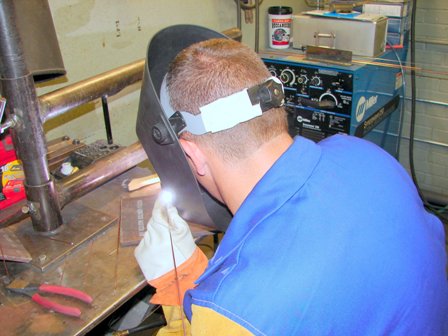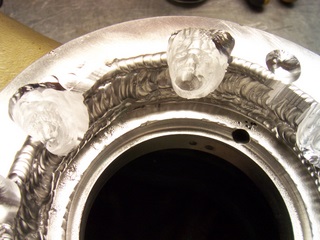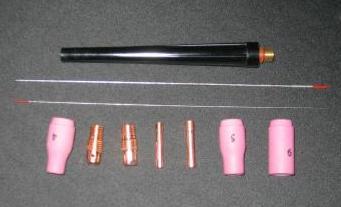Tig Welding Tips and Tricks - Down and Dirty WeldingTips For How To Tig Weld
- HOME
- TIG WELDING
- Tig Welding Tips
Plenty of TIG welding tips below...But first, lets watch this video
Click here for Tig Welding Tips # 1--7
Click here for Tig Tips # 8--11
Click here for Tig Tips # 12--17
Click here for Tig Tips # 18--23
Click here for Basic Tig Welding info
Tig Welding tip #24...Put a glove, block of wood, folded up heat resistant cloth or something non-conductive on the welding table to rest your arms or elbows on and to protect your arms from shock hazard

Do you enjoy getting shocked? Me neither . tig welding aluminum with your high frequency switched to continuous means that the high freq is always looking for a path to follow. So even resting your forearm on the metal table can let that high frequency current bite you just when you least want it, like right when you are near and edge and you are being extra careful not to melt the edge away and then ZAP!. Who needs that?
Put a glove, block of wood, folded up heat resistant cloth or something non-conductive on the welding table to rest your arms or elbows on and to protect your arms from shock hazard.
Also do whatever it takes to rest your torch hand on a steady object. Again, a block of wood, a balled up tape ball etc can all be used to give you something to rest your torch hand on.
You can also make a “hot finger” out of an old stick welding glove and use it to rest against the part to be welded. The “hot finger” is pretty common amongst pipe welders and boilermaker welders.
keep scrolling down for more tig welding tips
Tip #25...When welding oil soaked aluminum castings like engine blocks, or transmission cases...do cleaning passes with the tig torch...

When welding oil soaked aluminum castings like engine blocks, or transmission cases, clean the surface with acetone, alcohol or similar cleaner.
Route out any cracks with a really coarse carbide burr . (if you done have one try a drill bit)
Carefully heat the area with a oxy-acetylene torch or propane torch to cook out the oil.
Use a 300f temperature stick so you have some gauge to how hot the metal gets. (Its easy to overheat aluminum because it does not change color before it melts.) try to cook out the oil in the weld area without overheating the metal.
Then,…Go over the crack with the TIG torch with low amperage, barely puddle every now and then to see what it looks like. If it is shiny, that’s good. If it looks fuzzy, its still crapped up. Use as small a tungsten electrode as you can and still puddle the aluminum.
These are called cleaning passes. Do not add welding rod. Every time you go over the area it should get cleaner. You will see black discolored or fuzzy looking aluminum in the beginning.
Weld; grind; weld; grind, wire brush, lather rinse repeat.
Eventually the aluminum will be shiny silver color, then you can weld with filler rod and larger tungsten.
keep scrolling down for more tig welding tips
Tip #26...To keep sanding discs and carbide burrs from loading up with aluminum, use bees wax on the disc
You know how when you use a sanding disc on aluminum, it loads up and doesn’t cut after just a few seconds? To keep sanding discs and carbide burrs from loading up with aluminum, use bees wax on the disc. You will be blown away at the difference.
If you don’t have beeswax, use mineral spirits or WD40.
keep scrolling down for more tig welding tips
Tip # 27 ...A collet is designed to go in one direction. The tapered in points toward the tip of the tungsten

This sounds like a no brainer but I see it backwards all the time...
The reason this is important is that the chamfer on one end of the collet is designed to seat in the same angle chamfer that is up inside the collet body.
If the seat is not good then the shielding gas can stream out around the electrode instead of out of the diffuser screen or side diffuser ports.
This can make for a really turbulent flow of gas and can really make you pull your hair out trying to figure out the problem.
You can waste time adjusting your flow rate, checking for leaks, getting on the phone with your welding supply accusing them of selling you bad gas….when all the while the problem was so simple…your collet was in bassackwards.
You can get away with it sometimes. The tungsten will tighten, it might weld fine. All I am saying is that I have seen it happen more than once so why take a chance. Just put the stupid thing in the right way and be done with it.
keep scrolling down for more tig welding tips
Tig Welding Tip # 28...keep a good supply of sharp tungsten electrodes handy...
See page on Tungsten Sharpeners here...
...more tig welding tips
When TIG welding steel, nickel alloys, titanium, stainless steel, and all other corrosion and heat heat resistant alloys, you will be using DCEN aka straight polarity.
Whenever you are on DCEN, use a sharp electrode. Whether you use a hand held tungsten sharpener like the weldcraft triad, a “stilo tig” tungsten sharpener, belt sander, 4 inch electric grinder with sanding disc or grinding disc….the main thing is to use a sharp and clean electrode.
That means when you dip your wick, when you sputter the tip in the puddle and you are tempted to keep welding, stop and put sharp tungsten in.
That means keeping a big supply of pre sharpened electrodes handy.
A lot of welders make a tungsten holder out of copper tubing with a cap soldered on one end and another removable cap on the other end. It’s a pretty good way to carry around a good supply of sharp tungsten.
If you are constantly swapping tungsten size for the work you do, you may want to make separate copper tubing tungsten holders, one for each size tungsten you frequently use. and if you are using different color electrodes, you might want to only sharpen one end and leave the color code on the other.
tig welding tips 1-7
tips 8-11
tips 12-17
tips 18-23
tig welding 4130


















